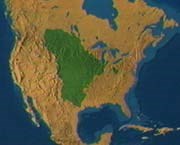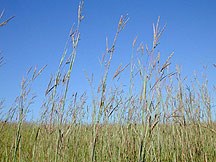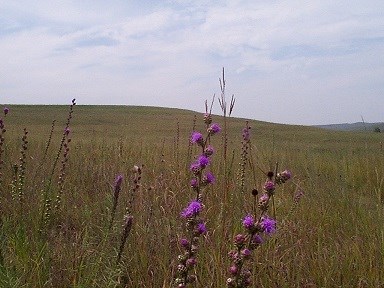
Inland Sea Productions photo. Prairies historically covered nearly one third of North America. This sea of grass stretched from the Rocky Mountains to east of the Mississippi River and from Saskatchewan, Canada south to Texas. It was the continent's largest continuous ecosystem supporting an enormous quantity of plants and animals. Prairies began appearing in the mid-continent from 8,000 to 10,000 years ago. They have developed into one of the most complicated and diverse ecosystems in the world, surpassed only by the rainforest of Brazil. 
NPS Photo Prairie climates range from two extremes. High heat and drought in August to bitter cold winters locked in ice with frigid winds. Prairies exist in areas too wet for desert yet too dry to support healthy forests. Prairies respond to their environment, which includes soil type, water availability, and natural disturbances such as fire and grazing. These resulted in three distinct prairie regions. In the rain shadow of Rocky Mountains, dry short-grass prairie thrives with ankle-high buffalo grass and blue grama. The eastern tallgrass prairies are wetter, supporting big bluestem, Indian grass, and switch grass up to eight feet in areas. Between these two lies the mid-grass prairie dominated by side-oats grama and wheatgrass. Midgrass prairies have a mixture of shortgrass prairies in dry sites and tallgrass in wetter sites. The prairie is well known for its fauna. Some authors have estimated between 30-60 million bison roaming the prairies prior to 1840. Elk, deer, and antelope also grazed in astounding numbers. Large predators preying on the grazers included grizzly bears, panthers, and wolves. Hoards of smaller wildlife from birds to pocket gophers adapted to this unique ecosystem. Tallgrass prairies are an extremely complicated web of life. Eighty percent of the foliage is dominated by 40-60 species of grass. The other 20% of the primary vegetation is composed of over 300 species of forbs or flowers. The prairie also has over 100 species of lichens, liverworts, numerous woody trees and shrubs along protected areas like creeks. Prairie landscapes vary in soil types, depth, moisture, and slope. This creates many different niches for plant communities to fit into. For example, in the wet seeps, sedges and prairie cord grass thrive where bluestem and buffalo grass would drown. Species which require more moisture and deeper soils thrive in bottomland prairie areas. The dry, shallow, wind-blown hilltops host the drought-hardy hairy grama 
NPS photo Fires sweep across the prairie consuming everything in their path. A barrage of organisms feed on prairie plants as fast as they grow. The secret to vegetation survival in such a hostile environment is underground. Three quarters of the prairie biomass, or plant material, is the root system. The visible plants on the landscape are merely the photosynthetic leaves gathering sunlight. Just beneath the surface lie the main stems or rhizomes, running horizontally. The ground protects them from drying, grazing, trampling, fire, and frost. Tough fibrous roots descend from these rhizomes. Roots of some plants such as dotted gayfeather (blazing star) grow 10 to 15 feet deep. The plant utilizes microscopic "rootlets" numbering in the billions. Even smaller than rootlets are mycorrhizae which draw in nutrients too small for rootlets to obtain. The roots are so numerous that they would stretch for miles if placed end-to-end. The competition for nutrients and resources is fierce. Plant roots interweave so thickly that early settlers cut bricks out of the sod to build homes and schools. Europeans discovered the rich soils that exist in the prairies around the 1860s. Finding the soils outstanding for crop production, they plowed the prairie anywhere they could to grow domestic crops like wheat and corn. Today, the most fertile and well-watered region, the tallgrass prairie, is less than 4% of its original area. This makes it one of the rarest and most endangered ecosystems in the world. The rocky Flint Hills of Kansas remains the largest region still unplowed. This geologic region averages 60 miles wide and stretches from the southern Nebraska border into northern Oklahoma. |
Last updated: March 5, 2022
